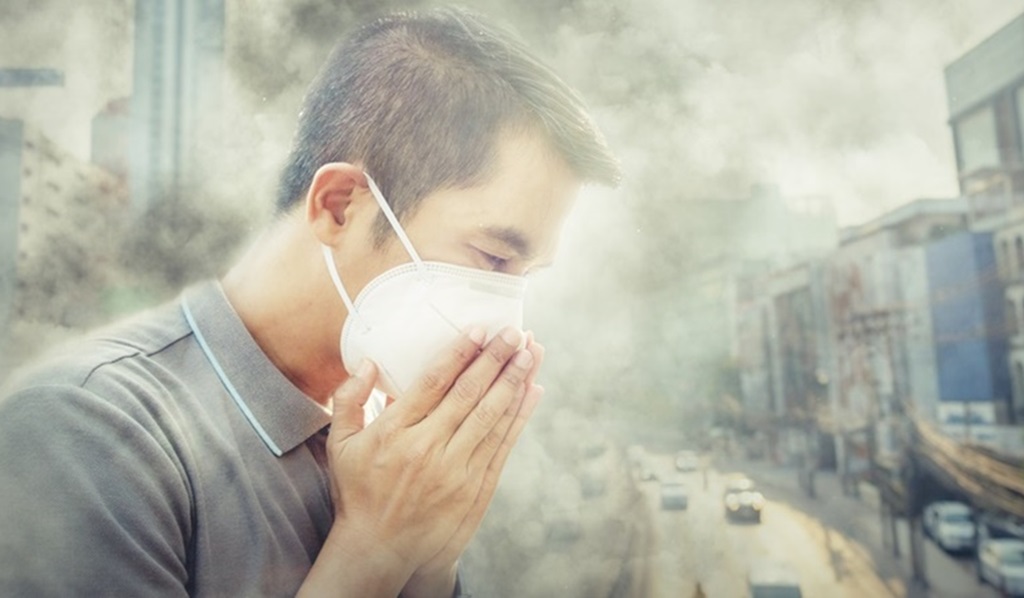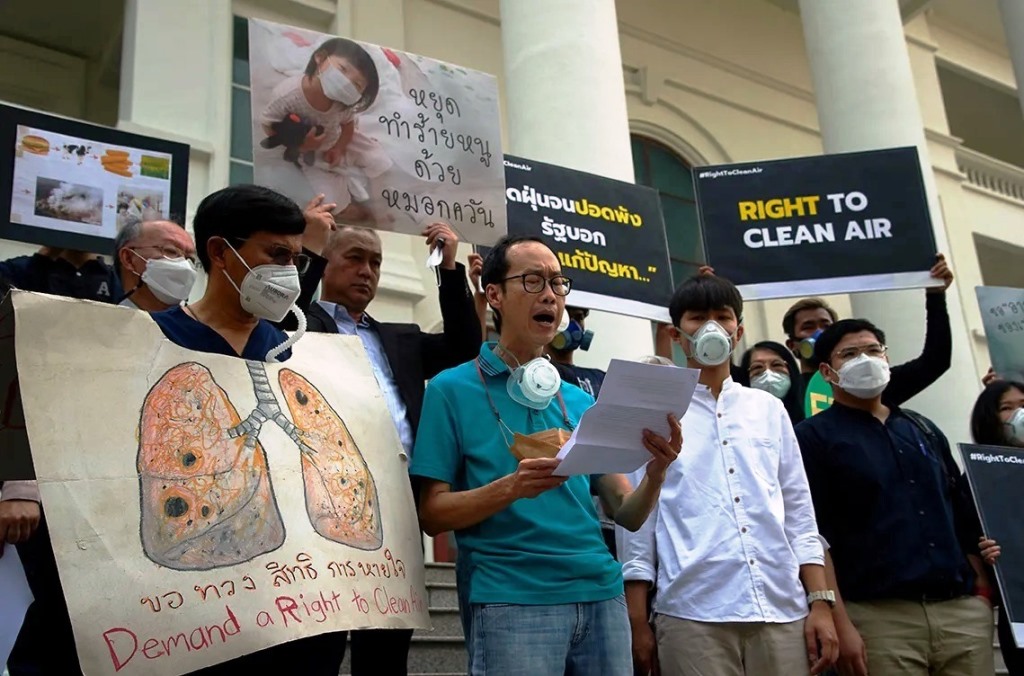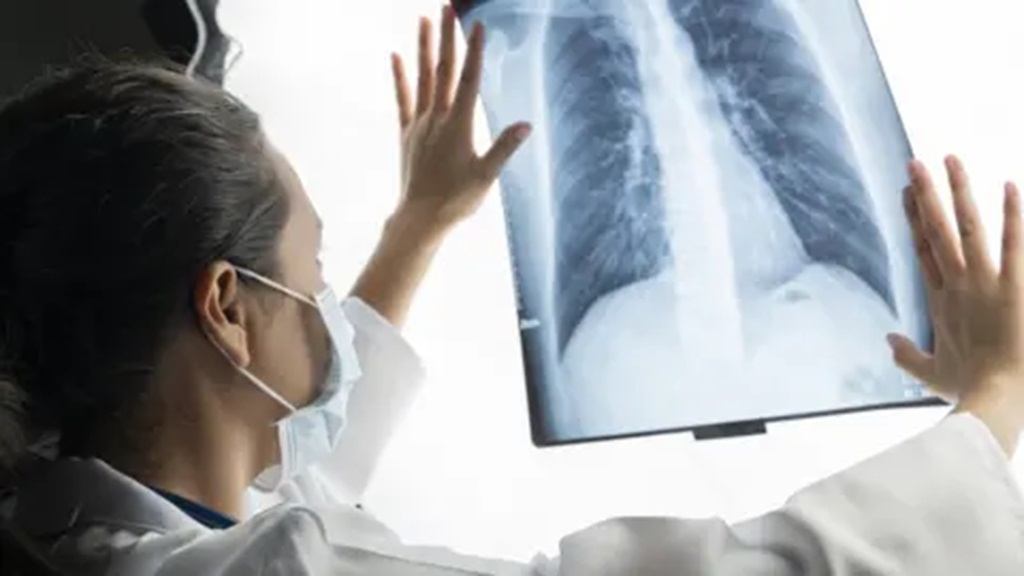A Hazardous toxic haze has blanketed 45 provinces, primarily in northern Thailand, with Chiang Mai seeing the highest levels of PM2.5 on Sunday. Chiang Mai is ranked as the city with the third highest level of PM2.5 dust in the atmosphere in the world.
At 1 p.m. on Sunday, the Geo-Informatics and Space Technology Development Agency reported that nine provinces had experienced red (seriously harmful) levels of particulate matter 2.5 micrometers or less in diameter (PM2.5) ranging from 78.9 to 126.1 microgrammes per cubic meter of air in the previous 24 hours. The safe threshold is 37.5 µg/m³.
The worst level was measured in the northern province of Chiang Mai, followed by 113.3 in Chiang Rai, 108.0 in Phayao, 104.5 in Nan, 104.0 in Mae Hong Son, 102.1 9 in Lamphun, 95.0 in Lampang, 79.8 in Tak, and 78.9 in Loei, the only province in a red zone outside of the north.
PM2.5 values in 36 other provinces, predominantly in the Northeast, were orange (quite dangerous). The values ranged from 38.1 to 69.5 µg/m³. Provinces in the lower Central Plain, part of the East and South, had moderate to good air quality. Samut Sakhon had the best air quality, with 12.9µg/m³ of PM2.5, followed by Samut Prakan at 13.5µg/m³.
At 2.10 p.m. on Sunday, Swiss air quality technology company IQAir named Chiang Mai the world’s worst air pollution major city.
Nirat Pongsitthaworn, the governor of Chiang Mai, blamed the problem on wildfires. He stated that the province needed more firefighters.
Lung Cancer Deaths Surge in Northern Thailand
People in northern Thailand, particularly Chiang Mai and Lampang, have a high mortality rate owing to lung cancer. The Faculty of Medicine at Chiang Mai University has identified increased levels of PM2.5 particles in the air as one of the primary culprits.
According to Associate Professor Chalerm Liewsisakul of Chiang Mai University’s (CMU) Faculty of Medicine, PM2.5 pollution in the northern region has worsened over the last decade, increasing in patients suffering from lung ailments.
According to one study, the rate of lung cancer deaths per 100,000 persons in the North climbed from 20.3 in 2010 to 30.7 in 2019. This compares to data for Bangkok (14.9 in 2010 to 22.6 in 2019), the Northeast (10.2 in 2010 to 17 in 2019), and the South (9.5 in 2010 to 16.8 in 2019).
According to data from 2010 to 2021, the northern provinces, particularly Chiang Mai and Lampang, have the highest death rates from lung cancer. This emphasizes the critical need for tailored initiatives to combat air pollution and its health impacts in these locations.
“In addition, the incidence of lung cancer among young people in the northern region is higher than in other locations. This correlation is most likely due to PM2.5 pollution, according to global data confirming the increased cancer risk, particularly lung cancer, associated with continuous exposure to PM2.5 particles,” he stated.
He cited a Faculty of Medicine study focusing on emphysema patients in Chiang Dao, an area known for high PM2.5 levels. A cell study of emphysema patients’ cheek scrapings revealed significant cellular alterations when PM2.5 levels were high compared to low. He said these changes indicate genetic anomalies that may lead to cancer cells in the future.
Furthermore, respiratory illnesses ranging from nosebleeds to persistent coughs have increased during elevated PM2.5 levels, notably in March. Severe illnesses such as emphysema exacerbations, coronary heart disease, and strokes are particularly common at these pollution peaks, emphasizing the acute health hazards associated with elevated PM2.5 levels.
A CMU’s Faculty of Medicine study found a concerning correlation between PM2.5 levels and deaths in Chiang Mai. For every 10 µg/m³ increase in daily average PM2.5 concentration, Chiang Mai’s mortality rate increased by 1.6% over the next six days.
The lab also determined the cause of death for Prof Rawiwan Olarnratmanee, a former dean of Chiang Mai University’s Faculty of Architecture. Test results revealed that the cancer cells discovered in her lungs had genetic abnormalities caused by PM2.5 exposure.
Her husband, Jittrakorn Olarnratmanee, stated that she was diagnosed with late-stage lung cancer in February and died from the disease on April 3. She was one of four university instructors who died from lung cancer in 2022.
According to Maharaj Nakorn Chiang Mai Hospital, 30,339 patients sought treatment for pollution-related disorders between January 1 and March 15, double the number from last year.
On Saturday, IQAir.com stated that the province has returned to the top of the list of cities in the world with the poorest air quality, with the Air Quality Index (AQI) reaching 237 at 8.52am.
Source: Bangkok Post, GIS Health








